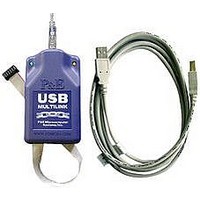USBMLPPCBDM Freescale Semiconductor, USBMLPPCBDM Datasheet - Page 4

USBMLPPCBDM
Manufacturer Part Number
USBMLPPCBDM
Description
MULTILINK P&E POWERPC USB
Manufacturer
Freescale Semiconductor
Series
USB Multilinkr
Type
In Circuit Debuggerr
Datasheet
1.USBMLPPCBDM.pdf
(6 pages)
Specifications of USBMLPPCBDM
Contents
Module and Misc Hardware
Leaded Process Compatible
Yes
Rohs Compliant
Yes
Peak Reflow Compatible (260 C)
Yes
For Use With/related Products
MPC5xx / 55xx
Lead Free Status / RoHS Status
Lead free / RoHS Compliant
If you connected the Multilink interface prior to installing the drivers, Windows will not have been able to
find the appropriate driver and may have disabled the device. If you unplug and reconnect the device,
Windows will automatically disable it even if you have installed the drivers. To force Windows to try to
load the driver again, perform the following steps while the USB PowerPC BDM Multilink interface is
plugged into the computer:
If you have purchased one of P&E’ s software development packages prior to July 1, 2005, contact P&E to
obtain the latest version which supports the USB PowerPC BDM Multilink interface (software support
for the cable is separate from Windows USB driver support). If you are using third-party software, make
sure you have a version which supports the USB PowerPC BDM Multilink interface.
4.0 Computers Running Windows 95, 98, ME, or NT
The USB PowerPC BDM Multilink is not supported under Windows 95 or NT. The USB PowerPC BDM
Multilink is not tested under Windows 98 and Windows ME, although drivers for these operating
systems are included in the install. For these operating systems, P&E produces the Parallel Port
CABLEPPC which connects the parallel port of the PC to the 10-pin debug connector on the target. For
more information, visit http://www.pemicro.com.
5.0 Using A USB Hub
The USB PowerPC BDM Multilink is classified as a high-power USB device which is powered from the
USB bus. A high-power device requires that if a USB hub is used, it must be a self-powered hub. This
means that it has a separate power supply from which it derives its operating power (as opposed to
deriving its power from the PC). It must be able to supply 500mA per port (a high-power USB device may
derive up to 500mA from the port).
6.0 Connecting To The Target
The following is the proper connection sequence to connect the PC to the target system via the USB
PowerPC BDM Multilink interface:
1) Make sure the target power is OFF and the USB PowerPC BDM Multilink is not connected to
2) Connect the Multilink to the target via its ribbon cable. Make sure that the ribbon cable is plugged
3) Connect the Multilink to the PC via a USB extension cable. This should light the Blue LED on the
1.) Open the Control Panel (Start Button->Settings->Control Panel)
2.) Double-click the “System” icon
3.) Select the “Hardware” tab
4.) Click the “Device Manager” button
5.) The “P&E PowerPC BDM Multilink” device will be shown with an exclamation mark next to
6.) Click the “Reinstall Driver… ” button and follow the dialog instructions to have Windows
either the target or the PC.
into the target with the proper orientation. PIN 1 is indicated by the red stripe running down the
ribbon cable.
Multilink.
it. Double-click this device.
automatically install the driver.





